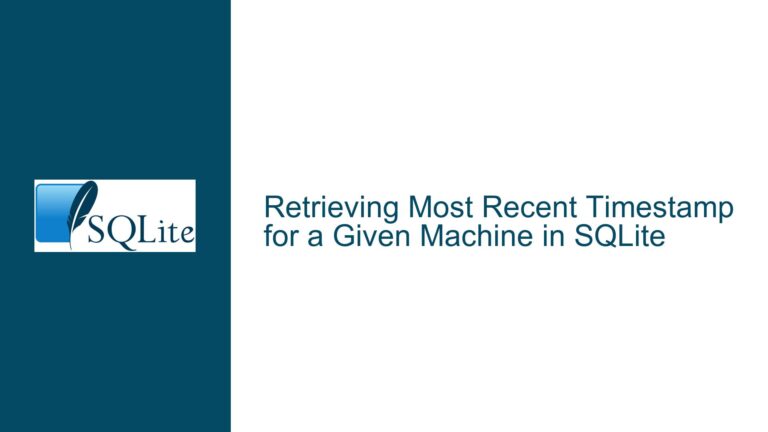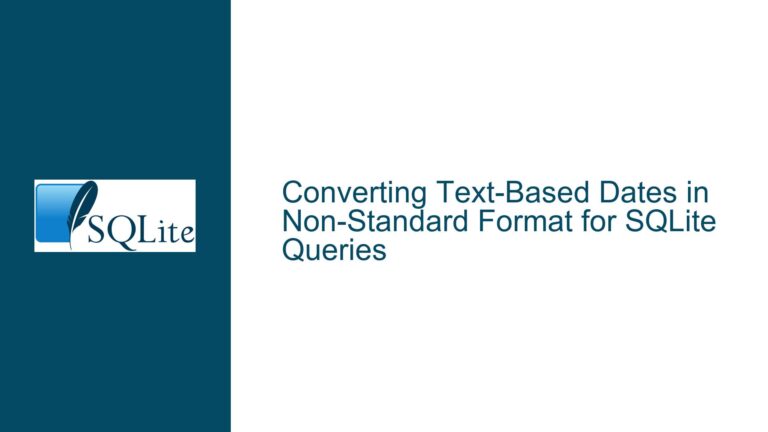and Resolving SQLite Column Reference Errors in SELECT Queries
Issue Overview: Column Reference Errors in SELECT Queries
When working with SQLite, one of the most common issues that developers encounter is the inability to reference a column alias within the same SELECT statement where it is defined. This issue arises due to the way SQLite processes and evaluates queries. Specifically, SQLite evaluates all expressions in the SELECT clause before assigning aliases to the resulting columns. This means that any attempt to reference an alias within the same SELECT statement will result in a "no such column" error, as the alias is not yet recognized during the evaluation phase.
In the provided example, the user attempts to calculate a derived column MaxGoLiveDate based on two other derived columns, LastGoLive and MinDate. The query fails because SQLite does not recognize LastGoLive and MinDate as valid columns when it tries to compute MaxGoLiveDate. This is a fundamental limitation of SQLite’s query processing model, and it requires a specific approach to work around.
The core of the problem lies in the order of operations within the SQLite query engine. When SQLite processes a SELECT statement, it first evaluates all expressions in the SELECT clause, then assigns aliases to the resulting columns, and finally applies any filtering, grouping, or ordering specified in the query. This means that any attempt to reference an alias within the same SELECT clause will fail, as the alias is not yet available during the expression evaluation phase.
Possible Causes: Misunderstanding SQLite’s Query Processing Model
The primary cause of the issue is a misunderstanding of how SQLite processes and evaluates SELECT statements. Specifically, the user is attempting to reference column aliases (LastGoLive and MinDate) within the same SELECT statement where they are defined. This is not possible in SQLite due to the way the query engine processes the query.
Another potential cause is the use of complex subqueries and Common Table Expressions (CTEs) without fully understanding how they interact with the main query. In the provided example, the user employs a CTE (LastEntries) to calculate the maximum idate for a specific pid. However, the user then attempts to use the results of this CTE in a way that requires referencing column aliases within the same SELECT statement, which is not supported.
Additionally, the user’s query involves multiple levels of nesting and subqueries, which can make it difficult to track the flow of data and understand how the different parts of the query interact. This complexity can lead to errors if the relationships between the different parts of the query are not clearly understood.
Troubleshooting Steps, Solutions & Fixes: Correcting Column Reference Errors in SELECT Queries
To resolve the issue of column reference errors in SELECT queries, it is necessary to restructure the query in a way that avoids referencing column aliases within the same SELECT statement. There are several approaches to achieving this, each with its own advantages and trade-offs.
1. Using Subqueries to Isolate Column Aliases
One effective approach is to use subqueries to isolate the calculation of derived columns, allowing them to be referenced in an outer query. This approach involves breaking the query into multiple parts, with each part responsible for calculating a specific set of columns. The results of these subqueries can then be combined in an outer query, where the derived columns can be referenced without issue.
In the provided example, the user can restructure the query to first calculate LastGoLive and MinDate in a subquery, and then use these results in an outer query to calculate MaxGoLiveDate. This approach ensures that the column aliases are available when they are needed, without violating SQLite’s query processing model.
Here is an example of how this can be done:
WITH LastEntries (ProjID, ml_insert) AS (
SELECT 'p001', max(idate)
FROM z WHERE pid = 'p001'
)
SELECT *,
(date(LastGoLive, '+' || (strftime('%d', LastGoLive) - strftime('%d', MinDate)) || ' days')) AS MaxGoLiveDate
FROM (
SELECT *,
(
SELECT max(bd) FROM z
WHERE pid = b.ProjID
AND idate = b.ml_insert
AND (
pn LIKE '%go-live%'
OR pn LIKE '%golive%'
OR pn LIKE '%go live%'
OR pn LIKE '%act98-%'
OR pn LIKE '%act098-%'
)
) AS LastGoLive,
(
SELECT min(bd) FROM z
WHERE pid = b.ProjID
AND idate = b.ml_insert
) AS MinDate
FROM z AS a
LEFT JOIN LastEntries AS b
)
ORDER BY bd;
In this restructured query, the inner subquery calculates LastGoLive and MinDate, and the outer query uses these results to calculate MaxGoLiveDate. This approach ensures that the column aliases are available when they are needed, without violating SQLite’s query processing model.
2. Using Common Table Expressions (CTEs) to Simplify Complex Queries
Another approach is to use Common Table Expressions (CTEs) to simplify complex queries and make them easier to understand and maintain. CTEs allow you to define temporary result sets that can be referenced within the main query, making it easier to break down complex queries into smaller, more manageable parts.
In the provided example, the user can use a CTE to calculate LastGoLive and MinDate, and then reference these results in the main query to calculate MaxGoLiveDate. This approach not only resolves the column reference issue but also makes the query easier to read and understand.
Here is an example of how this can be done:
WITH LastEntries (ProjID, ml_insert) AS (
SELECT 'p001', max(idate)
FROM z WHERE pid = 'p001'
),
AML (id, pid, pn, bd, ed, c, d, idate, ProjID, ml_insert, LastGoLive, MinDate) AS (
SELECT z.id, z.pid, z.pn, z.bd, z.ed, z.c, z.d, z.idate, b.ProjID, b.ml_insert,
(
SELECT max(z.bd) FROM z
WHERE z.pid = b.ProjID
AND z.idate = b.ml_insert
AND (
z.pn LIKE '%go-live%'
OR z.pn LIKE '%golive%'
OR z.pn LIKE '%go live%'
OR z.pn LIKE '%act98-%'
OR z.pn LIKE '%act098-%'
)
),
(
SELECT min(z.bd) FROM z
WHERE z.pid = b.ProjID
AND z.idate = b.ml_insert
)
FROM z
CROSS JOIN LastEntries AS b
)
SELECT AML.*,
date(AML.LastGoLive, '+' || (strftime('%d', AML.LastGoLive) - strftime('%d', AML.MinDate)) || ' days') AS MaxGoLiveDate
FROM AML
ORDER BY AML.bd;
In this restructured query, the AML CTE calculates LastGoLive and MinDate, and the main query uses these results to calculate MaxGoLiveDate. This approach not only resolves the column reference issue but also makes the query easier to read and understand.
3. Avoiding Complex Expressions in the SELECT Clause
In some cases, the best approach is to avoid complex expressions in the SELECT clause altogether. Instead, you can calculate the necessary values in a separate query or subquery, and then use these results in the main query. This approach can simplify the query and make it easier to understand and maintain.
In the provided example, the user can calculate LastGoLive and MinDate in a separate query, and then use these results in the main query to calculate MaxGoLiveDate. This approach avoids the need to reference column aliases within the same SELECT statement, and it can make the query easier to read and understand.
Here is an example of how this can be done:
WITH LastEntries (ProjID, ml_insert) AS (
SELECT 'p001', max(idate)
FROM z WHERE pid = 'p001'
),
GoLiveDates (ProjID, ml_insert, LastGoLive, MinDate) AS (
SELECT b.ProjID, b.ml_insert,
(
SELECT max(z.bd) FROM z
WHERE z.pid = b.ProjID
AND z.idate = b.ml_insert
AND (
z.pn LIKE '%go-live%'
OR z.pn LIKE '%golive%'
OR z.pn LIKE '%go live%'
OR z.pn LIKE '%act98-%'
OR z.pn LIKE '%act098-%'
)
),
(
SELECT min(z.bd) FROM z
WHERE z.pid = b.ProjID
AND z.idate = b.ml_insert
)
FROM LastEntries AS b
)
SELECT z.*,
date(g.LastGoLive, '+' || (strftime('%d', g.LastGoLive) - strftime('%d', g.MinDate)) || ' days') AS MaxGoLiveDate
FROM z
LEFT JOIN GoLiveDates AS g ON z.pid = g.ProjID AND z.idate = g.ml_insert
ORDER BY z.bd;
In this restructured query, the GoLiveDates CTE calculates LastGoLive and MinDate, and the main query uses these results to calculate MaxGoLiveDate. This approach avoids the need to reference column aliases within the same SELECT statement, and it can make the query easier to read and understand.
Conclusion
In summary, the issue of column reference errors in SELECT queries is a common challenge when working with SQLite. The key to resolving this issue lies in understanding how SQLite processes and evaluates queries, and in restructuring the query to avoid referencing column aliases within the same SELECT statement. By using subqueries, CTEs, and avoiding complex expressions in the SELECT clause, you can work around this limitation and achieve the desired results. With these techniques, you can write more efficient, readable, and maintainable SQLite queries, and avoid the pitfalls of column reference errors.






